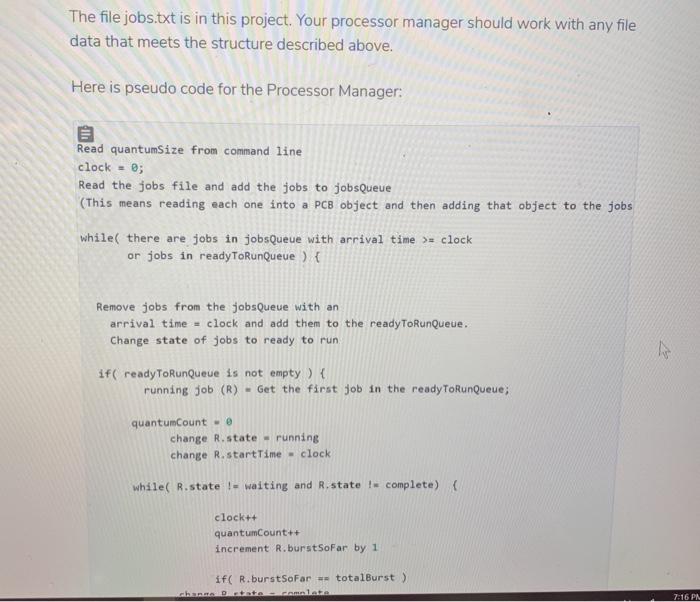1. Processor Manager You will develop a processor manager for a single-processor, multi-programming system. The processor manager will include the tasks of the job scheduler and the process scheduler. The job scheduler will use a first-in, first out policy. The process scheduler will use the round-robin algorithm with a quantum of 5ms.. Define the following structures in your code: 1. Process Control Block You can define a class or a struct for the PCB. The PCB should have fields for pid, state, arrival time, completion time, total burst, burst so far, priority. class PCB public: int pid; string state; I waiting, running, complete int arrivaltime; // time it arrived at the Ready Quue int startTime; // this will be the clock time (in ms) int completionTime; int totalBurst; int burstSoFar; // increment each time process gets a ms on the cpu int priority: Feel free to define the class with private members and public getters/setters if you wish (that really is the correct way to do it) 2. Job Queue 2. Job Queue vector
jobQueue; // jobs arriving into the system will get added here 3. Ready Queue vector readyToRunQueue; // jobs that are waiting to run are in this queue Upon start up, your program will read the file jobs.txt to get a list of the jobs. These jobs are added to the jobQueue. The file contains a list of 5 space-delimited records that define a job and has the following structure: pid state arrival-time start-time completion-time total-burst burst-so-far priority Here is an example: jobs.txt 2 hold 200701 8 hold 100602 1 hold 5 00302 5 hold 0 00804 4 hold 3 0 0 2 05 The file jobs.txt is in this project. Your processor manager should work with any file data that meets the structure described above. Here is pseudo code for the Processor Manager: Read quantumSize from command line clock = 0; Read the jobs file and add the jobs to jobsQueue (This means reading each one into a PCB object and then adding that object to the jobs while( there are jobs in jobsQueue with arrival time >= clock or jobs in ready To RunQueue ) { Remove jobs from the jobsQueue with an arrival time = clock and add them to the readyToRunQueue. Change state of jobs to ready to run if( ready To RunQueue is not empty ) { running job (R) - Get the first job in the ready To RunQueue; quantumCount - @ change R.state - running change R.startTime - clock while( R.state = waiting and R.state complete) { clock++ quantumCount++ increment R.burstSoFar by 1 if( R.burstSoFar == totalBurst) chantate commet 7:16 PM 1. Processor Manager if( R.burstSofar -- totalBurst) change R.state = complete change R.completionTime = clock update statistics: wait time, completion time, turnaround time else if( quantumCount == quantum) change R.state = waiting add R to readyToRunQueue Remove jobs from the jobsQueue with an arrival time = clock and add to them readyToRunQueue } // end while quantun not } else { // readyqueue empty, there are future jobs, cpu idle clock } // while Jobs available At the end of the simulation your Processor Manager should generate the following report: Job | TOTAL WAIT TIME I COMPLETION TIME TURNAROUND TIME 0101012 110102 Total simulation time: 5 Average Turnaround time: 2 Average Waiting time: 2 When your program is executed, the quantum size will be passed on the command line. ./a.out 5 int main(int argc, char** argv) { if( arge jobQueue; // jobs arriving into the system will get added here 3. Ready Queue vector readyToRunQueue; // jobs that are waiting to run are in this queue Upon start up, your program will read the file jobs.txt to get a list of the jobs. These jobs are added to the jobQueue. The file contains a list of 5 space-delimited records that define a job and has the following structure: pid state arrival-time start-time completion-time total-burst burst-so-far priority Here is an example: jobs.txt 2 hold 200701 8 hold 100602 1 hold 5 00302 5 hold 0 00804 4 hold 3 0 0 2 05 The file jobs.txt is in this project. Your processor manager should work with any file data that meets the structure described above. Here is pseudo code for the Processor Manager: Read quantumSize from command line clock = 0; Read the jobs file and add the jobs to jobsQueue (This means reading each one into a PCB object and then adding that object to the jobs while( there are jobs in jobsQueue with arrival time >= clock or jobs in ready To RunQueue ) { Remove jobs from the jobsQueue with an arrival time = clock and add them to the readyToRunQueue. Change state of jobs to ready to run if( ready To RunQueue is not empty ) { running job (R) - Get the first job in the ready To RunQueue; quantumCount - @ change R.state - running change R.startTime - clock while( R.state = waiting and R.state complete) { clock++ quantumCount++ increment R.burstSoFar by 1 if( R.burstSoFar == totalBurst) chantate commet 7:16 PM 1. Processor Manager if( R.burstSofar -- totalBurst) change R.state = complete change R.completionTime = clock update statistics: wait time, completion time, turnaround time else if( quantumCount == quantum) change R.state = waiting add R to readyToRunQueue Remove jobs from the jobsQueue with an arrival time = clock and add to them readyToRunQueue } // end while quantun not } else { // readyqueue empty, there are future jobs, cpu idle clock } // while Jobs available At the end of the simulation your Processor Manager should generate the following report: Job | TOTAL WAIT TIME I COMPLETION TIME TURNAROUND TIME 0101012 110102 Total simulation time: 5 Average Turnaround time: 2 Average Waiting time: 2 When your program is executed, the quantum size will be passed on the command line. ./a.out 5 int main(int argc, char** argv) { if( arge











